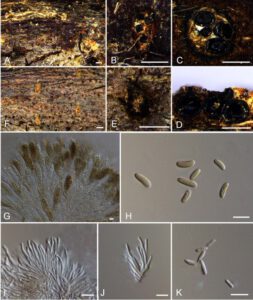Allocryptovalsa castaneae N. Jiang & X.L. Fan, in Zhu, Pan, Wijayawardene, Jiang, Ma, Dai, Tian & Fan, Frontiers in Microbiology 12(no. 646262): 5 (2021)
Index Fungorum Number: IF 837777, MycoBank Number: MB 837777, Facesoffungi Number: FOF 14960
Etymology – Named after the host genus from which it was collected, Castanea.
Diagnosis – Phylogenetically sister to Allocryptovalsa rabenhorstii, differs by the smaller size of ascospores (8–11 × 2.5–3.5 vs. 13.5–15 × 4–5 µm).
Descriptions – Necrotrophic on branches of Castanea mollissima. Sexual morph: Stromata solitary to gregarious, immersed in the bark, erumpent through the surface of the bark, with 3–5 perithecia arranged irregularly (0.3–)0.5–0.8 mm (av. = 0.6 ± 0.2 mm, n = 10) in diam. Ectostromatic disc orange, unconspicuous, circular to oblong, with 3–5 ostioles arranged irregularly per disc. Ostioles numerous, brown to black, at the same level as the disc, scattered (85–)120–130 µm (av. = 122.4 ± 14.0 µm, n = 10) in diam. Perithecia outer surface lacking powdery entostroma, black, flask-shaped to spherical, with discrete perithecial necks (320–)360–400(−420) µm (av. = 379.7 ± 19.7 µm, n = 10) in diam. Asci clavate to elongate obovoid, polysporous, thin-walled, short pedicellate. Ascospores elongate-allantoid, thin-walled, pale yellowish to pale brown at maturity, slightly curved, aseptate, 8–11(–13) × 2.5–3.5 (–4) µm (av. = 10.1 ± 0.8 × 3.1 ± 0.4 µm, n = 30). Asexual morph: Coelomycetous. Conidiomata pycnidial, immersed in the bark, scattered, erumpent through the surface of bark. Ectostromatic disc flat or concave, orange, surrounded by bark flaps, circular to ovoid, with 8–10 ostioles arranged circularly on per disc (200–)260–320(–370) µm (av. = 280.8 ± 43.3 µm, n = 10) in diam. Ostioles black, at the same level as the disc surface (45–)60–70 µm (av. = 64.1 ± 9.8 µm, n = 10) in diam. Conidiogenous cells holoblastic conidiogenesis, approximately cylindrical, hyaline, integrated, arising from pseudoparenchymatous cells, unicellular, with wide base producing conidia at the apex (15–)19–30(–31) × (1–)1.5–2(–2.5) µm (av. = 24.5 ± 4.9 × 1.7 ± 0.2 µm, n = 30). Conidia hyaline, elongate-allantoid, not curved, smooth, aseptate (4–)5–7(–8) × (1–) 1.5–2(–2.5) µm (av. = 5.9 ± 0.9 × 1.8 ± 0.2 µm, n = 30).
Culture characteristics – Cultures are initially white with irregular margin, becoming dark green at the margin and stopping growing with 7 cm in diam. after 2 weeks, comprising dense, irregular, flat mycelium.
Known host and distribution – Known on Castanea mollissima and Juglans regia in China.
Typification – CHINA. Hebei Province, Qinhuangdao City, Qinglong County, 119◦ 110 52.2500 E 40◦ 220 52.1300 N, 246 m msl., from branches of Castanea mollissima, 16 Oct. 2017, C.M. Tian & N. Jiang, holotype BJFU CF2020518, ex-type culture CFCC 52428. ibid., isotype BJM 240506, ex-isotype culture CFCC 52429.
Additional collection examined – CHINA. Yunnan Province, Chuxiong Yi Autonomous Prefecture, Dayao County, 101◦ 200 15.700 E 25◦ 440 47.1900 N, 2,002 m msl., from branches of Juglans regia, August 07, 2015, N. Zhao, paratype BJFU CF2020516, ex-paratype culture CFCC 52427.
Notes – Three new strains isolated from branches of Castanea mollissima and Juglans regia, show high support value (MP/ML/BI = 99/100/1) with the closely clustered isolates in Allocryptovalsa. Moreover, this species has different morphological characters. Other species of this genus were not reported with asexual morph. Therefore, Allocryptovalsa castaneae showed a coelomycetous asexual morph from the host in China for the first time. In addition, Allocryptovalsa castaneae differs from A. castaneicola (from Castanea mollissima), A. cryptovalsoidea (from Ficus carica), A. elaeidis (from Elaeis guineensis), A. polyspora (from Hevea brasiliensis), and A. rabenhorstii (from Vitis vinifera and Sambuscus nigra) in host association (Saccardo, 1882; Trouillas et al., 2011; Senwanna et al., 2017; Konta et al., 2020). apically rounded (52–)60–83(–92) × (11–)12–17(–25) µm (av. = 71.5 ± 11.4 × 14.4 ± 2 µm, n = 30).

FIGURE 1.| Holomorph of Allocryptovalsa castaneae (BJFU CF2020518, holotype). (A) Ascomata on the host. (B) Ascoma on the host. (C) Transverse section of ascoma. (D) Longitudinal section through ascoma. (E) Conidiomata on the host. (F) Conidioma on the host. (G) Asci and ascospores. (H) Ascospores. (I,J) Conidia attatch to conidiogenous cells. (K) Conidia. Scale bars: (A,F) = 1 mm; (B–E) = 500 mm; (G–K) = 10 mm.
